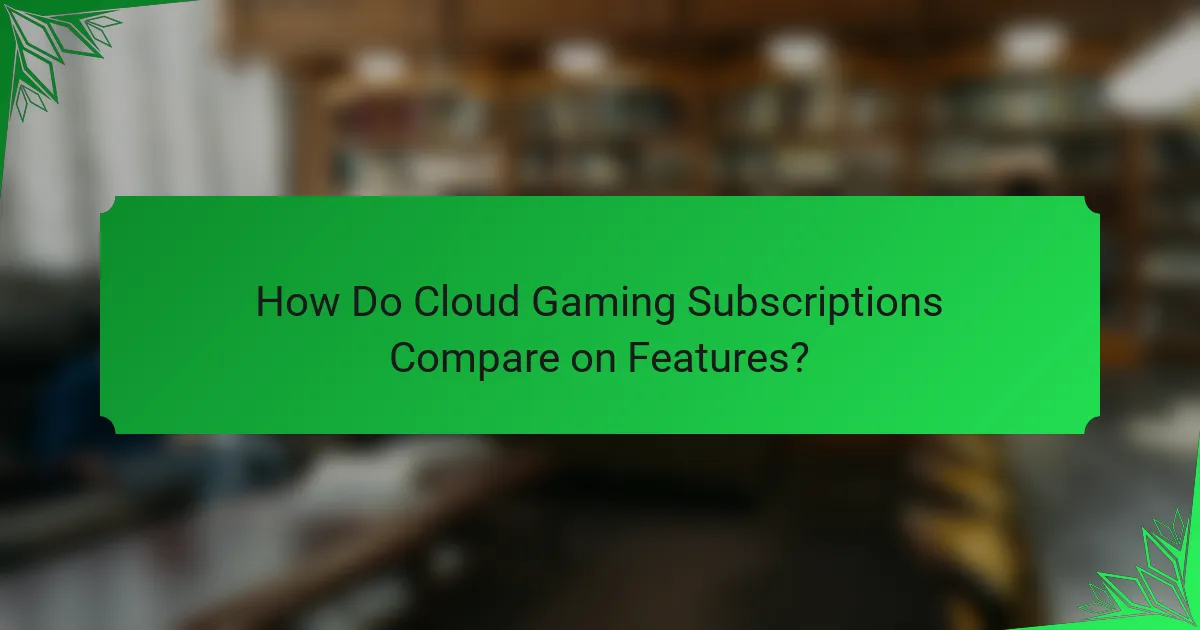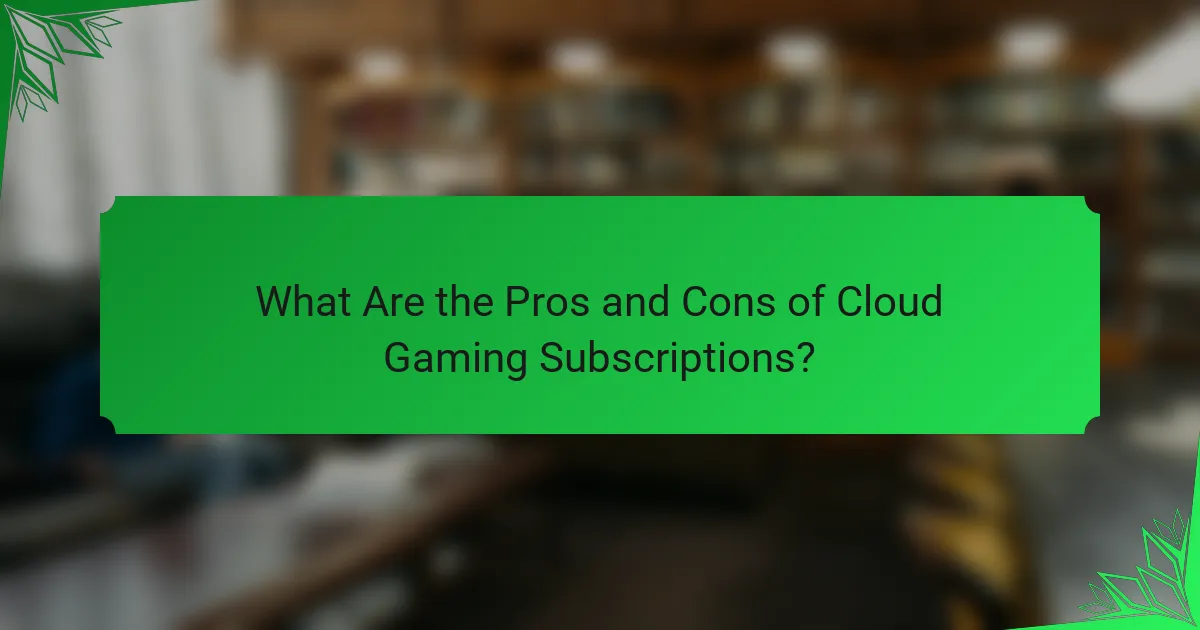Cloud gaming subscriptions have emerged as a popular option for gamers seeking flexibility and convenience, but their value can vary widely. When evaluating these services, it’s essential to consider factors such as game selection, performance, and pricing to find the best fit for individual preferences. Additionally, features like streaming quality, device compatibility, and multiplayer options play a crucial role in shaping the overall user experience.

What Are the Best Cloud Gaming Subscriptions for Value?
The best cloud gaming subscriptions for value offer a balance of game selection, performance, and pricing. Users should consider their gaming preferences, the available library, and the subscription costs to determine which service provides the most benefit for their needs.
NVIDIA GeForce NOW
NVIDIA GeForce NOW allows users to stream games they already own from platforms like Steam and Epic Games. Its free tier offers limited session lengths, while paid plans provide longer play sessions and access to higher performance servers.
Consider the library of games you own and whether they are compatible with GeForce NOW. The service excels in performance, often delivering low latency and high-quality graphics, making it a strong choice for competitive gamers.
Xbox Cloud Gaming
Xbox Cloud Gaming, part of Xbox Game Pass Ultimate, enables players to stream a vast library of games on various devices. This subscription is particularly valuable for those who already own an Xbox console, as it integrates seamlessly with existing game libraries.
The service offers a rotating selection of titles, so it’s essential to check the current library to ensure it includes the games you want to play. With a monthly fee in the range of USD 15, it provides access to hundreds of games, making it a cost-effective option for avid gamers.
PlayStation Plus Premium
PlayStation Plus Premium combines cloud gaming with a selection of classic and modern titles. This subscription allows users to stream games directly to their PlayStation consoles or PC, enhancing accessibility.
With a monthly cost around USD 18, it includes a library of popular games and exclusive titles. Users should evaluate the available games and consider whether the service aligns with their gaming interests, particularly if they enjoy PlayStation exclusives.
Google Stadia
Google Stadia offers a unique cloud gaming experience by allowing users to purchase games individually and stream them without the need for a console. The service is designed for ease of use, requiring only a stable internet connection.
While Stadia has a subscription option for access to a selection of games, many users find value in purchasing specific titles. However, the service’s future has been uncertain, so potential subscribers should consider this risk before committing.
Amazon Luna
Amazon Luna provides a cloud gaming platform with a subscription model that offers access to a library of games. Users can choose from different channels, each featuring a unique selection of titles, allowing for tailored gaming experiences.
The service is priced competitively, typically around USD 10 per month for the base channel. It’s essential to review the available games and channels to ensure they align with your gaming preferences, as the library may vary significantly between channels.

How Do Cloud Gaming Subscriptions Compare on Features?
Cloud gaming subscriptions vary significantly in features, impacting user experience and overall value. Key areas to consider include game library size, streaming quality, device compatibility, and multiplayer options.
Game Library Size
The size of the game library is a crucial factor when evaluating cloud gaming subscriptions. Most services offer a range of titles, from popular AAA games to indie releases, but the total number can vary widely. For example, some platforms may feature hundreds of games, while others may have a more limited selection.
When choosing a subscription, consider what genres you prefer and whether the library includes recent releases. Services that frequently update their libraries with new titles can provide better long-term value.
Streaming Quality
Streaming quality affects the overall gaming experience, including resolution, frame rate, and latency. Many cloud gaming platforms support resolutions up to 4K and frame rates of 60 fps, but achieving this quality depends on your internet connection. A stable connection with speeds of at least 15 Mbps is generally recommended for optimal performance.
Be aware of potential latency issues, which can range from low tens of milliseconds to higher values that may disrupt gameplay. Testing the service during peak and off-peak hours can help gauge its reliability.
Device Compatibility
Device compatibility is essential for accessing cloud gaming services. Most platforms support a variety of devices, including PCs, consoles, smartphones, and smart TVs. However, some services may have restrictions on specific devices or operating systems.
Before subscribing, check if your preferred devices are supported and whether any additional hardware is required. For instance, some services may perform better on dedicated gaming hardware compared to standard devices.
Multiplayer Options
Multiplayer options can enhance the gaming experience, allowing you to play with friends or join online communities. Many cloud gaming subscriptions offer robust multiplayer features, including cross-platform play and social integration.
Evaluate whether the service supports your favorite multiplayer titles and how it handles matchmaking and community features. Some platforms may offer exclusive multiplayer events or tournaments, adding further value to the subscription.

What Is the User Experience Like with Cloud Gaming?
The user experience with cloud gaming can vary significantly based on factors like internet speed, platform choice, and game selection. Generally, players enjoy the convenience of accessing games without the need for powerful hardware, but they may encounter challenges related to latency and interface usability.
Latency Issues
Latency is a critical factor in cloud gaming, as it affects the responsiveness of gameplay. Players often experience delays ranging from low tens of milliseconds to over a hundred milliseconds, which can disrupt the gaming experience, especially in fast-paced genres like first-person shooters.
To mitigate latency issues, a stable and fast internet connection is essential. Ideally, players should aim for a minimum download speed of 15 Mbps for a smooth experience, though higher speeds are recommended for optimal performance.
Interface Usability
The usability of cloud gaming interfaces can greatly influence user satisfaction. Many platforms offer intuitive layouts, but some may have complex navigation that can frustrate users. A well-designed interface should allow easy access to game libraries, settings, and support options.
When choosing a cloud gaming service, consider user reviews and trial periods to assess the interface’s usability. Look for platforms that provide customizable controls and seamless integration with existing gaming peripherals.
Customer Support
Effective customer support is vital in addressing issues that may arise during cloud gaming. Many services offer multiple channels for support, including live chat, email, and community forums. Response times can vary, so it’s beneficial to check user feedback on support effectiveness.
Before committing to a subscription, review the customer support options available. Services with 24/7 support and comprehensive FAQs tend to provide a better user experience, especially for troubleshooting connectivity or performance issues.
Community Feedback
Community feedback plays a significant role in shaping the cloud gaming experience. Online forums and social media platforms often provide insights into user experiences, highlighting common issues and successful strategies. Engaging with the community can help new users navigate challenges more effectively.
Consider exploring community reviews and discussions before selecting a cloud gaming service. Platforms with active user communities tend to offer valuable tips and updates on game performance, enhancing the overall experience for players.

What Factors Should You Consider When Choosing a Subscription?
When selecting a cloud gaming subscription, consider pricing, trial periods, and internet speed requirements. These factors significantly influence the overall value, usability, and enjoyment of the gaming experience.
Pricing Models
Pricing models for cloud gaming subscriptions can vary widely, typically falling into monthly, yearly, or pay-per-play categories. Monthly subscriptions often range from $10 to $30, while annual plans may offer discounts, reducing the monthly cost to as low as $5 to $20. Pay-per-play options allow users to pay only for the games they play, which can be economical for casual gamers.
Evaluate what each model includes, such as access to exclusive titles or additional features like cloud saves. Some services may also charge extra for premium content or higher resolution streaming, so it’s essential to read the fine print.
Trial Periods
Many cloud gaming services offer trial periods, allowing users to test the platform before committing financially. These trials typically last from a few days to a month, providing access to a limited selection of games or features. Take advantage of these trials to assess the service’s performance and library.
During the trial, pay attention to how the platform runs on your hardware and network. This experience can help you determine whether the subscription meets your gaming needs without any upfront investment.
Internet Speed Requirements
Internet speed is crucial for a smooth cloud gaming experience. Most services recommend a minimum download speed of 15 Mbps for standard gameplay, while higher resolutions may require speeds of 25 Mbps or more. Latency is another critical factor; aim for a ping under 30 ms for optimal performance.
Before subscribing, test your internet connection to ensure it meets these requirements. If your speed fluctuates, consider upgrading your plan or optimizing your network setup to avoid lag and interruptions during gameplay.

What Are the Pros and Cons of Cloud Gaming Subscriptions?
Cloud gaming subscriptions offer a mix of advantages and disadvantages. On the positive side, they provide access to a wide library of games without the need for expensive hardware. However, users may face issues like latency and the need for a stable internet connection.
Cost Efficiency
Cloud gaming subscriptions can be a cost-effective alternative to traditional gaming. Instead of purchasing individual games or consoles, users typically pay a monthly fee that grants access to a large selection of titles. This can save money, especially for gamers who frequently try new games.
For instance, a subscription might range from $10 to $20 per month, allowing access to hundreds of games. In contrast, purchasing games individually can cost $60 or more each. This model is particularly appealing for casual gamers who want to explore various genres without significant financial commitment.
However, it’s essential to consider potential hidden costs, such as high-speed internet requirements or additional fees for premium titles. Users should evaluate their gaming habits and internet capabilities before committing to a subscription service.
